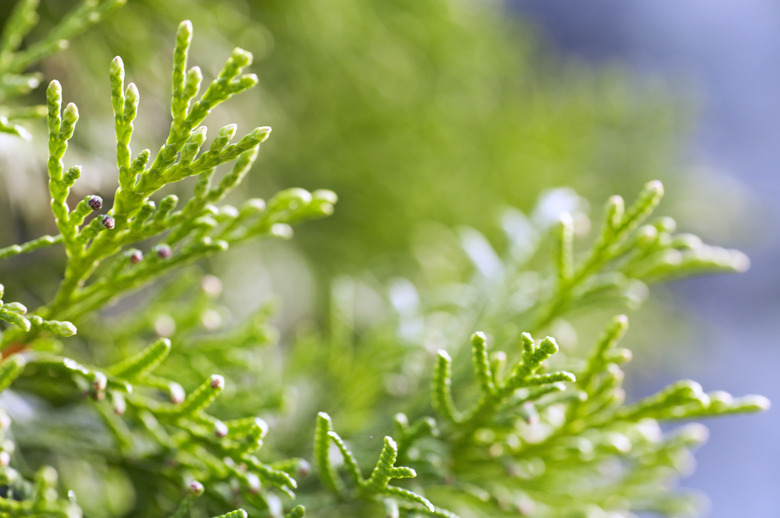Problems With Thuja Giants
Giant thuja (Thuja plicata), or giant arborvitae, is a tough, hardy evergreen that grows rapidly and has few pests. Hardy in U.S. Department of Agriculture plant hardiness zones 5 through 8, it has a strong structure and, despite its quick growth rate, is long-lived. This pyramidal tree has attractive, rich green foliage that often turns a bronze or brownish color in cold temperatures. Few pests dare to bother this evergreen giant, but many of the problems come from the size of the thuja itself.
Size
Many homeowners and landscapers look at thuja's fast growth rate and plant this evergreen without hesitation. Years later, however, the thuja dwarfs other plantings and even homes. Giant thujas grow 15 to 20 feet wide and twice as tall — as much as a towering 80 feet. Although this makes the giant thuja a fine choice for windbreaks or screens in large areas, it often overwhelms a residential yard. Trimming up these giants creates a "lollipop" effect, with a large, pyramidal crown balancing on an unattractive, scar-riddled trunk.
Homeowners can carefully maintain and trim the thuja season after season, but sudden shearing of outer foliage results in bare, twiggy branches that rarely fill in with new growth. Homeowners may easily avoid this problem; thuja cultivars come in many sizes. Research mature sizes carefully and select an appropriate site away from power lines, fences or other structures. Always take the future size of surrounding plants into consideration as well.
Deer Damage
Giant thuja is a hungry deer's salad bar. If your home shares land with deer, prepare to constantly defend your thuja from roving grazers. Deer damage may not be severe in some areas, but deer often strip giant thuja's lower leaves and branches, leaving the supporting, bare twigs exposed and creating a top-heavy plant. Like thoughtless pruning, this damage does not recover easily and may never recover at all. Instead of planting thuja, consider a spruce (Picea spp.), hardy is USDA zones 2 through 8, pine (Pinus spp.), hardy from USDA 2 through 11, or other evergreen. Ask your state university cooperative extension service office for suggestions.
Winter Damage
The green, scaled leaves of thuja may sustain winter damage, especially in newly-planted specimens. The foliage, especially on the south side of the plant, becomes brown and haggard. The winter sun heats the thuja, encouraging growth, before the icy night falls or winter winds desiccate the leaves. In late summer, reduce or stop supplemental water. This allows the evergreen time to prepare for harsher weather instead of pushing new growth.
Bagworms
Bagworms are as repulsive as they sound. These destructive caterpillars weave elongated, 2-inch-long bags among the thuja's foliage, hiding, pupating and laying hundreds of eggs for the following season. Although bagworms, in small populations, may not cause serious damage, uncontrolled infestations eventually decimate the host tree. Hand-pick the bags from young, smaller thujas or use an appropriate pesticide in early summer, when the caterpillars are young and easily killed. Use an insecticide like a ready-to-use product containing carbaryl and cover the plant's foliage, reapplying weekly if needed. Always follow the particular product's label and wash hands after using.
